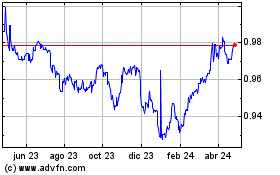Weekly Gains For Dollar As Fed Hawks Abound
13 Noviembre 2023 - 3:54AM
RTTF2
Hawkish commentary from Fed officials including by Chair Jerome
Powell helped the U.S. Dollar rebound against major currencies
during the week spanning November 6 to 10. The Dollar gained
comfortably against the euro, the British Pound, the Australian
Dollar as well as the Japanese Yen after a week of decline
triggered by softer-than-expected jobs data.
The Dollar Index, a measure of the Dollar's strength against a
basket of 6 currencies added 0.80 percent during the week ended
November 10 as aggressive monetary policy commentary by Fed
speakers forced markets to scale back rate cut expectations. The
Dollar's climb was steady over the course of the week, with the
Dollar Index rising from a low of 104.85 touched on Monday to a
high of 106.01 on Friday. The index however closed a tad lower at
105.86, versus 105.02 a week earlier.
The Dollar's rebound was primarily driven by hawkish Fed
commentary over the week. Recent Fed speakers tried hard to hint
that it was not yet time to confirm an end to the Fed's monetary
tightening cycle and that inflation combat was still beset with
challenges. Chair Jerome Powell on Thursday stated that the Fed was
not confident that it had done enough to bring inflation down. He
also warned that the Fed would not hesitate to raise interest rates
if it became appropriate to tighten policy.
U.S. ten-year bond yields increased to 4.646 percent from 4.576
percent a week earlier, reflecting the market's anxiety on interest
rates remaining higher for longer than anticipated, expediting the
Dollar's surge.
The euro slipped close to half a percent against the U.S. dollar
during the week spanning November 6-10, causing EUR/USD to close
the week's trading at 1.0681, versus the level of 1.0729 a week
earlier. The pair ranged between the high of 1.0757 traded on
Monday and the low of 1.0655 traded on Friday. The euro's movements
come amidst the ECB trying to balance between high borrowing costs
and the risks of a painful recession. ECB President Christine
Lagarde had on Friday indicated that despite the massive drop in
inflation, the ECB would not cut interest rates in the next couple
of quarters.
The pound too slipped against the U.S. dollar over the course of
the week ended November 10, despite Bank of England Governor Andrew
Bailey hinting at no immediate rate cuts. The GBP pair shed 1.24
percent as it plunged to 1.2222, from the level of 1.2376 recorded
a week earlier. The weekly trading range for the pair was slightly
wider, between a high of 1.243 and a low of 1.2186. Data released
on Friday had shown that U.K.'s economic growth in the third
quarter was steady at 0.6 percent year-on-year, slightly above
forecasts of 0.5 percent. In September, GDP grew by 0.2 percent
month-over-month versus 0.1 percent growth in August and forecasts
of a flat reading.
The more-than 2-percent weekly drop in the value of the Aussie
against the U.S. Dollar came amidst the sharp monetary policy
divergence between the two central banks. The Fed which had paused
on rate hike in its recent review nevertheless maintained a hawkish
posture whereas the Reserve Bank of Australia delivered a 25-basis
points hike but tempered it with a dovish commentary regarding the
need for additional measures. The AUD/USD pair recorded a weekly
decline of 2.3 percent as it tumbled to 0.6364, from 0.6512 a week
earlier. The pair's trading range was between a high of 0.6524
recorded on Monday and the low of 0.6338 recorded on Friday.
The more-than-expected dovishness in recent monetary policy
action and commentary from Bank of Japan abetted the yen's
weakness, causing the USD/JPY pair to trade above the psychological
150 level for most part of the week. Bank of Japan persisting with
negative interest rates contrasted with the Fed trying hard to push
back expectations of rate cuts, adding to the monetary policy
divergence. From the low of 149.24 recorded on Monday, the pair
climbed to a high of 151.62 by the end of the week. Helped by a
weekly gain of 1.43 percent over the course of the week, the
USD/JPY pair closed at 151.50, versus 149.37 a week earlier.
Anxiety ahead of the release of the CPI numbers from the U.S.
now hold sway over the greenback's fortunes. The Dollar Index has
increased to 105.95 versus 105.86 at Friday's close. The EUR/USD
pair has declined to 1.0671 whereas the GBP/USD pair has increased
to 1.2243. The AUD/USD pair is flat at 0.6366. The USD/JPY pair is
currently at 151.81 after touching a high of 151.90. The pair had
closed on Friday at 151.50.
Euro vs CHF (FX:EURCHF)
Gráfica de Divisa
De Jun 2024 a Jul 2024

Euro vs CHF (FX:EURCHF)
Gráfica de Divisa
De Jul 2023 a Jul 2024
